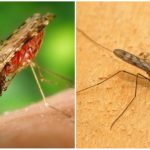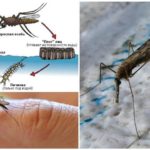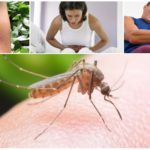What do malaria mosquitoes look like and how dangerous they are for humans
Content
- Malaria mosquito
- Breeding cycle of the Anopheles mosquito
- Consequences of the Malaria Mosquito Bite
The malaria mosquito is the hero of multiple frightening stories, one of the most dangerous representatives of the numerous mosquito family, including more than 3 thousand mosquito species. His bites cause the development of a very dangerous disease - malaria. In order not to panic prematurely, it is necessary to study the dangerous insect in more detail and learn how to identify it among other non-dangerous species.
Systematics and distribution
In Latin, its name sounds like Anopheles. It belongs to the order Diptera and has more than 400 species. It is even known that 2 of them are fossil and became extinct many years ago. Mosquitoes - carriers of malaria, which can be found on the territory of Russia, account for 10 species.
You can meet these representatives almost anywhere in the world. The exception is too cold regions. The malaria mosquito lives in Russia in the European part and in Western Siberia. The unfavorable climate of Eastern Siberia made it impossible for these insects to live in the region. Anopheles necessary close proximity of reservoirs to be able to reproduce. Residents of the Republic of Tatarstan and Kazan suffer most from these insects in the summer.
Important!
Representatives of anopheles mosquitoes live in the Far East. But the characteristics of the local climate, which impede the completion of the life cycle of malaria plasmodium, make it impossible to spread a disease like malaria.
Most of them can be found in tropical countries. The highest death rate from malaria was also noted there.Sometimes these bloodsuckers are met in regions where the disease has been defeated.
Most often they are found in areas near the equator. It is here that every year a huge number of people die from malaria, the majority of whom are children under 5 years old.
External features
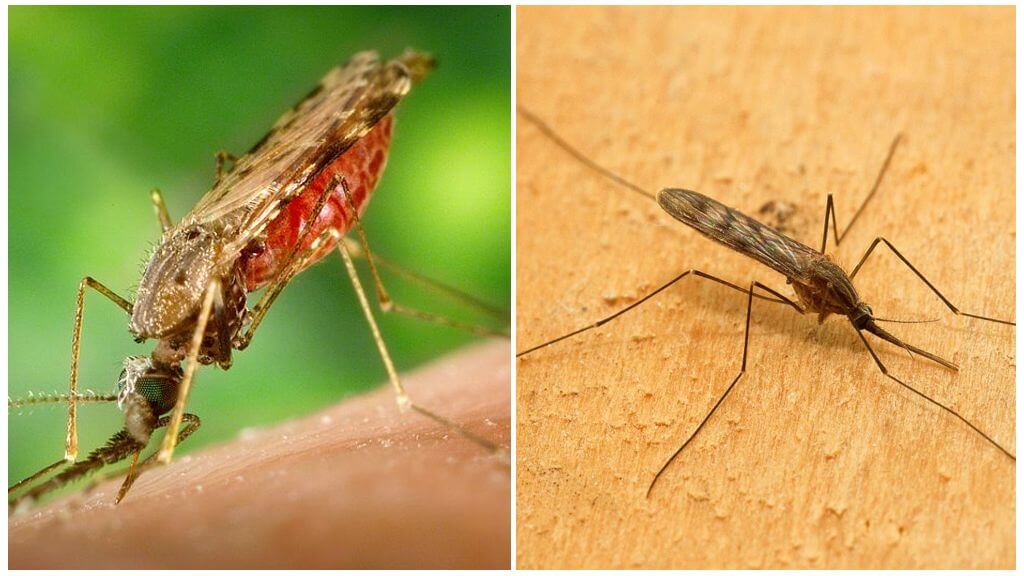
To more clearly assess how the anopheles mosquito looks like, just look at his photo. The insect has a long and thin body, the size of which is 6-14 mm. The color of the body is dark gray or brown. The malaria mosquito has a pair of narrow transparent wings. The body consists of small segments, with clearly visible dark stripes on the back.
Piskun, mosquito and the anopheles mosquito have many similarities. They are characterized by an identical lifestyle and body structure. The appearance of the species may vary depending on the season, sex and area of distribution.
To distinguish a mosquito from an anopheles mosquito will be easy if you know some features of each type:
- The size. Anopheles is a big mosquito, it is 1.5 times larger than a regular piskun.
- The structure of the paws. Long hind limbs. They are almost 2 times longer than the front.An ordinary mosquito has all the paws of almost the same length.
- Mouth apparatus. It has a pair of tentacles, the length of which is similar to the proboscis. In a typical mosquito, the tentacles are somewhat shorter.
- Bands on the body. The Pikun has a uniform gray body.
The most characteristic difference is its location during feeding. It is at an angle of 45 degrees relative to the substrate, which is clearly visible in the photo of the anopheles mosquito.
The life cycle and development of insects
The development cycle of the malaria mosquito includes the same steps as the regular mosquito:
- Egg.
- Larva.
- Baby doll
- Imago or adult.
The female lays eggs in the ponds. It is there that most of the development of offspring occurs. The period of maturation from egg to adult is 1-2 weeks. In the imago stage, the anopheles mosquito spends about 2 months. The time, how many insects of this species live and develop may vary depending on climatic conditions. Sufficient moisture and moderate lighting are optimal for development.
What mosquitoes eatdepends on gender. After mating the female goes in search of the victim.For this, she has a developed sense of smell, which helps to catch the desired smell at very long distances. After that, she goes to a suitable place where the laying takes place. During laying, she may not eat. The male malaria mosquito has a different structure of the oral apparatus and, therefore, its diet consists of plant juices.
Important!
Often malarial called caramor. This species has a body length of 6 cm and is absolutely safe for humans and other living creatures.
For laying eggs, the female chooses cotton algae. As in them young individuals will be best developed.
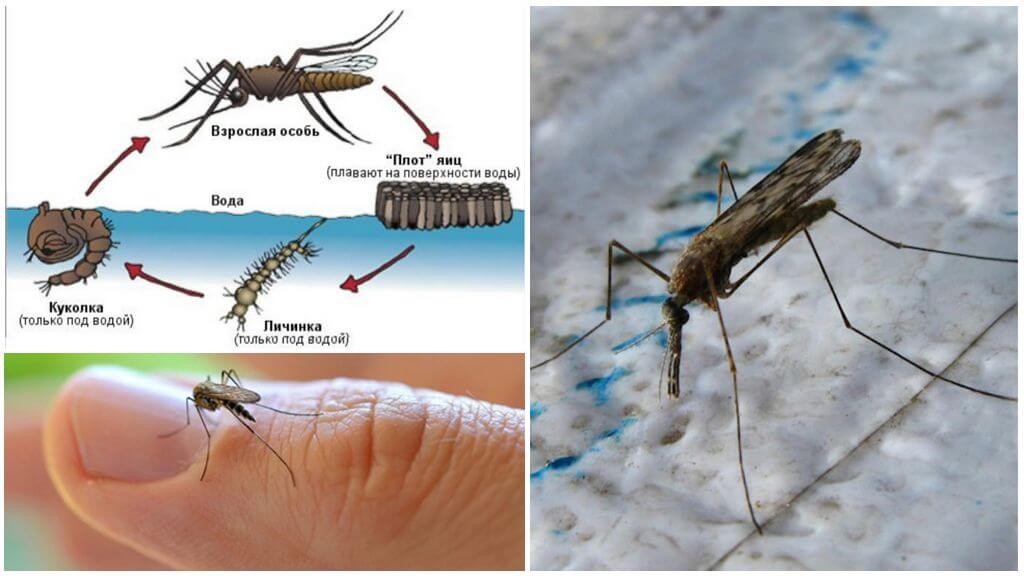
What are they dangerous
The striped mosquito is dangerous for a person only if he previously drank the blood of an infected person. That is, mosquitoes only carry pathogens of a dangerous disease, and are not a source in fact. According to statistics, up to 3 million people die from malaria every year. The vast majority of them live in Africa.
Important!
Not all representatives of this species can be carriers of malaria. Mosquito anopheles is a danger to humans only in those regions where there is an outbreak of the disease itself. Where there are no infected people, the representatives of this insect species are completely safe.
The causative agent is malarial plasmodium. These are unicellular microorganisms that develop in human blood cells. There, the plasmodium multiplies and devastates all their contents. After destroying the contents of one red blood cell, he moves to another. In the period of release of the pathogen in humans, there is an acute stage and a strong fever.
The most dangerous carrier of malaria is pregnant women and young children, as their weakened immune system will not be able to fully fight the infection.
Important!
Also, malaria mosquitoes can carry pathogens of HIV infection, anthrax and many intestinal infections.
The consequences of an attack at first are no different from bite of an ordinary mosquito piskun: swelling, itching, redness and burning sensation.
Next, the malarial plasmodium develops in the liver and from there enters the blood. Progressing in the circulatory bodies, malaria leads to regular fevers, which are replaced by chills. Fever is characterized by periodicity. Attacks occur every 3 days, after which there is a short period of improvement.Eventually, the blood vessels in the brain become clogged and the infected person die.
The most common deaths are children from 6 months to 5 years. Infants have passive immunity, which their mother passed to them. For pregnant women, malaria is dangerous with preterm labor, eclampsia and death.
What to do if you are bitten by an anopheles mosquito

The first thing to do is call an ambulance. Next, wash the bite wound with an alcohol solution and apply a cold. The victim is placed in bed and provided with abundant drinking. When the deterioration of the heart muscle, patients inject caffeine or adrenaline. Additionally, you should use an antihistamine drug to reduce the allergic reaction. Often, people have anaphylactic shock due to over-stimulation.
Important!
Acute signs of infection can be noted only for 10-15 days after the pathogen enters the body.
Additional symptoms of the disease:
- nausea;
- vomiting;
- pain at the site of the bite;
- suffocation;
- yellowness of the whites of the eyes and skin;
- increased sweating;
- convulsions.
It is important to be able to prevent infection.To do this, while staying in places where malaria mosquitoes are found, it is necessary to use the maximum number of possible protective equipment:
You can also use folk remedieshow to kill the pike mosquito. They are also effective against the malarial.
Thus, the malaria mosquitoes pose a great danger to human life. Preventive measures can be taken to prevent infection and avoid disease. effective mosquito repellent while staying outside.

